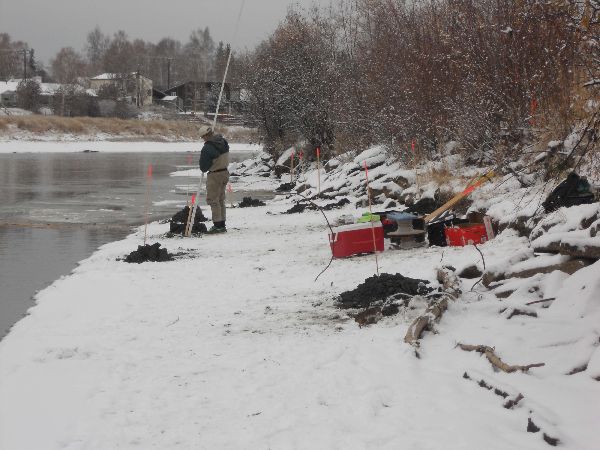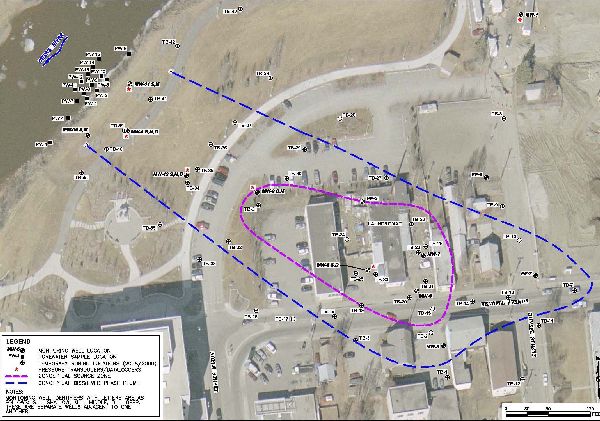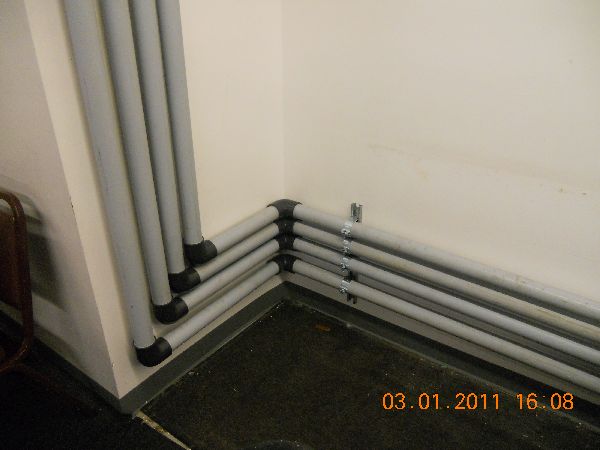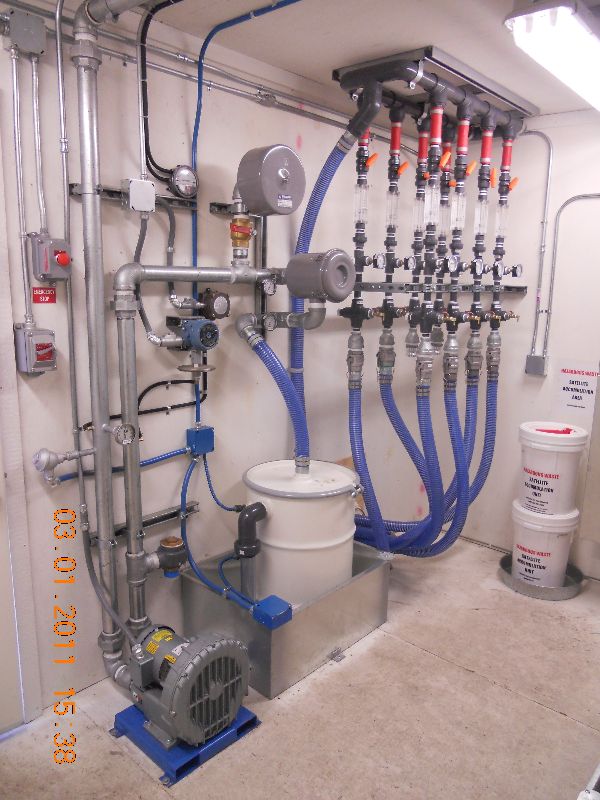Wendell Avenue (MC Cleaners)
- View detailed information from the database on this site.
- Database Name: 314 Wendell Ave
- Status: Active
- Location: Fairbanks
- Latitude: 64.845060
- Longitude: -147.714560
DEC Contaminated Sites contact: Axl Levan, Project Manager, 907-451-2156 (Fairbanks)
- Click on photos or maps for larger versions.
- Contacts updated: 12/19/2022
- Summary updated: 8/9/2012
Site Narrative

Figure 1. The arrow points to the building at 314 Wendell Ave. that now houses ES Cleaners, formerly MC Commercial Cleaners. The river is the Chena River. (Photo courtesy of Bing Maps.)
Current Status
The Alaska Department of Environmental Conservation has installed both a soil vapor extraction system and sub-slab depressurization system at 314 Wendell Ave. to address chlorinated solvent contamination in the soil. Both systems are operating to remove chlorinated solvents from the soil, and to try to stop contaminant vapors in the soil from entering the building through cracks in the cement foundation – a process called vapor intrusion.
The main contaminant is tetrachloroethene, a chlorinated solvent that’s a common dry cleaning chemical also known as perchloroethylene, PERC, or PCE. In the remedial systems, a series of extraction wells installed in the source area draw chlorinated solvent vapors from the soil pore spaces (the air between the soil particles) and exhaust them to the atmosphere. The soil vapor extraction, or SVE, system removes contaminants from the surrounding soils as vapor, while the sub-slab depressurization, or SSD, system creates a vacuum-induced negative pressure beneath the building’s foundation slab to prevent vapor intrusion and remove contamination from soils beneath the building.
What is vapor intrusion?
Many chemicals off fumes – these chemicals are called “volatile.” When released into the soil or groundwater, a certain amount of the chemical vaporizes into the small air spaces within the soil. The larger the chemical spill and the more volatile the chemical, the more chemical vapors move into the air spaces. This air is called soil gas. If the air pressure inside the building is lower than in the soil, or if the amount of chemicals in the soil gas is high, the vapors move, or intrude, into any open space, such as cracks in foundations, crawl spaces and basements. People in buildings can sometimes smell a chemical, but often the chemicals are odorless or too faint to smell.

Figure 2. A DEC contractor samples pore water along the banks of the Chena River in October 2010. (Oasis Environmental Inc. photo, for DEC)
By removing the contaminants from soil, the risk of vapor intrusion is reduced, and the migration of the contaminant to groundwater below is reduced. DEC and its contractors evaluate the effectiveness of both systems by continued vapor intrusion assessments and the collection of soil gas.
Groundwater monitoring wells have also been installed at the site and in Griffin Park to monitor contaminant concentrations, and to better understand subsurface geochemistry and groundwater-surface water interactions. As the groundwater moves toward the Chena River, microbes and certain minerals in the soil can transform, or degrade, the main contaminant, PCE, into TCE, or trichloroethylene, and other compounds. TCE has been found in the sediment pore water of the Chena River – where groundwater discharges into the river – indicating the migration and discharge of contaminants to the river.
Some background
The contaminated soil around Wendell Avenue was first discovered and reported to DEC in 2000 and 2001, when contractors were doing routine real estate environmental assessments for the construction of the nearby Morris Thompson Cultural and Visitor Center.

Figure 3. The sampling locations for groundwater and pore water are shown, along with the test borings installed in 2008 and 2009. The purple dashed lines show the conceptualized source area, and the blue dashed lines show the plume of dissolved contaminants. (Oasis Environmental Inc. diagram, for DEC)
Investigators then identified four or five businesses in the area that could have used and released chlorinated solvents into the sewer. One of those was MC Commercial Cleaners, at 314 Wendell Ave. It has also operated as Neighborette Laundry, White Swan Laundry, Quality Cleaners and Laundry, B&C Commercial Dry Cleaners and Laundry, Fairbanks Cleaners and Linen Supplies, and currently as ES Laundry. (See arrow in Figure 1.)
In 2002, DEC asked the current and past property owners of 314 Wendell Ave. to pay to finish the investigation into the solvent releases, but they were financially unable to do so. Then in 2007, DEC hired a contractor to sample the soil gas and indoor air at the dry cleaners and two properties to the south, due to an increased concern that vapors from the contamination were entering buildings where people work.
The soil gas concentrations from the sampling showed a significant release of solvents at 314 Wendell. DEC completed a full release investigation in 2008. Additional site characterization, vapor intrusion sampling, groundwater monitoring and a remediation feasibility study have occurred since 2008. (See the individual reports in the More Information section below.)

Figure 4. ES Cleaners, formerly MC Commercial Cleaners, at 314 Wendell Ave., is shown in this October 2009 photo, along with the neighboring buildings. The red lines leaving the ES Cleaners building show sewer lines that exit the building and connect to the sewer main under Wendell Avenue. The IA markers indicate indoor air sampling locations, the SS markers indicate sub-slab soil gas sampling locations, and the AA markers show ambient outdoor air sampling locations. (Oasis Environmental Inc. diagram, for DEC)
A summary of what we’ve found
The results of the site investigations confirm there have been significant releases of chlorinated solvents from historic operations at 314 Wendell. PCE, along with its degradation products, are the primary contaminants of concern in soil, soil gas and groundwater.
As mentioned earlier, PCE can be degraded by microbial activities in the soil and groundwater, to trichloroethene (TCE), dichloroethenes (DCE), vinyl chloride (VC), and ultimately ethene and chloride. Both PCE and some of these breakdown products have been detected in the soils and groundwater at the site, particularly downgradient and closer to the Chena River. Often the microbial biodegradation processes proceed slowly, or even stall, producing these intermediate degradation products that can continue to contaminate soil and groundwater. Transformations of the PCE at the Wendell Avenue site have resulted in TCE being found in pore water of the Chena River above groundwater cleanup levels, indicating that contaminants are being transported in groundwater that eventually discharges to the river. (See Figures 2 and 3.)
In addition to the soil and groundwater impacts, contaminant vapors are also present and are migrating from the soil into the three nearby buildings that DEC has tested. (See Figure 4.) Of those three buildings, only the one, at 314 Wendell, has indoor air concentrations that are significantly above risk-based levels, but the presence of vapors at each building indicates a potential risk that must be addressed during the cleanup of the area. DEC and the Alaska Department of Health and Social Services are working with the owners to keep them informed of these issues and help alleviate the risk as necessary.
The investigations included taking samples of indoor air, soil, soil gas and groundwater. Each of these kinds of samples gives us a better picture of where the contamination is and how it might move, along with the risk it might present to people who use the property, now and in the future. The data indicate the soil, groundwater and soil gas across the 314 Wendell site has chlorinated ethene contamination above DEC’s cleanup levels. (PCE and TCE, as maximum concentrations found, are summarized in the chart below.)
| What we sampled | Acceptable levels | Highest level found (prior to remediation) | February 2012 levels |
|---|---|---|---|
| PCE in indoor air | 270 micrograms per cubic meter – for health risks other than cancer | 1,400 micrograms per cubic meter | 3.4 micrograms per cubic meter |
| PCE in indoor air | 21 micrograms per cubic meter – for cancer risks in commercial settings | 1,400 micrograms per cubic meter | 3.4 micrograms per cubic meter |
| PCE in indoor air | 8.1 micrograms per cubic meter – for cancer risks in residential settings | 1,400 micrograms per cubic meter | 3.4 micrograms per cubic meter |
| PCE in sub-slab soil gas | 210 micrograms per cubic meter – the target level at commercial buildings | 5,900,000 micrograms per cubic meter | 400 micrograms per cubic meter |
| PCE in deep soil gas | 2,100 micrograms per cubic meter – the target level at commercial buildings | 970,000 micrograms per cubic meter | 720 micrograms per cubic meter |
| PCE in soil | 0.024 parts per million, or ppm – the regulatory cleanup level | 4,200 ppm | Not re-sampled |
| PCE in groundwater | 5 parts per billion, or ppb –the regulatory cleanup level | 13,000 ppb | 2,600 ppb (varies with season) |
| TCE in the pore water of the Chena River | 5 ppb – the regulatory cleanup level | 5.7 ppb | 2.1 ppb (varies with season) |
The two remediation systems operating now are addressing soil contamination and mitigating vapor intrusion at 314 Wendell, and they likely reduce the potential for vapor intrusion in other nearby buildings. (See Figures 6-9.)
Since operation of the remediation systems began, the concentration of PCE in sub-slab soil gas has dropped from 5,900,000 micrograms per cubic meter (measured in October 2010) to 400 micrograms per cubic meter (measured in February 2012 at the same location). Although the 400 is still above DEC’s target level of 210 micrograms per cubic meter (for commercial sub-slab soil gas), it represents a significant reduction in contaminant concentration, which will eventually lead to reduced exposure risks.

Figure 5. DEC Project Manager James Fish shows the in situ sampler, called a Bio Trap™ sampler, that he’s installing into a monitoring well in June 2012. (DEC photo)
Our future plans
DEC plans to continue operating the soil remediation systems, and continue evaluating their effectiveness through continued vapor intrusion assessments. The systems may need to operate for many years to remove contaminants in soil and mitigate exposure risks.
DEC is also considering future groundwater remediation strategies by monitoring seasonal trends of contaminant concentrations and geochemistry in groundwater, sediment pore water and surface water. DEC has also recently deployed in situ samplers – “in place” samplers with the brand name Bio Traps™ in this case (see Figure 6) – to better understand the subsurface microbiology of the contaminated site. DEC will use that information to evaluate the best long-term remediation strategy for groundwater cleanup.
If you have any questions or need additional information, please contact James Fish, DEC’s project manager for the site, at (907) 451-2117 or james.fish@alaska.gov.
More information
- The Contaminated Sites Program’s Vapor Intrusion Web page, DEC.
- Fact Sheet (October 2023) – “Vapor Intrusion,” Contaminated Sites Program, DEC (PDF)
- The former Wendell Site Summary on the Contaminated Sites Program website (September 2008), Contaminated Sites Program, DEC.
- Fact Sheet (May 2008) – “Sampling Assessment of Vapor Intrusion,” Contaminated Sites Program, DEC (PDF)
- Fact Sheet (November 2007) – “Vapor Intrusion Sampling Information, Wendell Avenue Vapor Intrusion Assessments,” Contaminated Sites Program, DEC (PDF)
- Aerial Map (January 2004), “MC Commercial Laundry and Dry Cleaners, Figure 1,” Contaminated Sites Program, DEC (PDF)
- Fact Sheet (January 2004) – “MC Commercial Laundry & Dry Cleaners, 314 Wendell Ave., Fairbanks, Alaska,” and aerial Contaminated Sites Program, DEC (PDF)
- Aerial Map (January 2004) – “MC Commercial Laundry and Dry Cleaners, Figure 2, Sample Locations in 2001,” Contaminated Sites Program, DEC (PDF)
- Aerial Map – 2001 and 2002 Groundwater PCE Concentrations in micrograms per cubic liter, Contaminated Sites Program, DEC (PDF)
Figures 6-9. The soil vapor extraction and sub-slab depressurization systems installed at 314 Wendell Ave. are shown in these March 2011 photos. (Oasis Environmental Inc. photo, for DEC)
Reports
- “Site Interim Status Reports,” December 2010 and June 2011, Oasis Environmental, Inc.
- “Soil Vapor Extraction Treatability Study, Wendell Avenue, Fairbanks, Alaska,” November 2010, Oasis Environmental, Inc.
- “Chena River Monitoring Plan, Wendell Avenue Site, Fairbanks, Alaska,” October 2010, Oasis Environmental, Inc.
- “Vapor Intrusion Assessment, Additional Characterization, Wendell Avenue, Fairbanks, Alaska,” July 2010, Oasis Environmental, Inc.
- “Additional Site Characterization, Wendell Avenue, Fairbanks, Alaska,” June 2010, Oasis Environmental, Inc.
- “Feasibility Study, Wendell Avenue Site, Fairbanks, Alaska,” June 2010, Oasis Environmental, Inc.
- “Data Summary Report, Wendell Avenue Site, Fairbanks, Alaska,” July 2009, Oasis Environmental, Inc.
- “Release Investigation, Wendell Avenue, Fairbanks, Alaska” April 2009, Oasis Environmental, Inc.
- “Wendell Avenue Vapor Intrusion Assessment,” June 2008, Oasis Environmental, Inc.
- “Phase II Environmental Site Assessment Wendell Avenue Area, Blocks 2 and 7, Fairbanks Townsite, Fairbanks, Alaska,” May 30, 2001, Nortech Environmental Engineering, Health and Safety.
- “Contamination Investigation Report, Fairbanks Townsite, Block 2,” Sept. 13, 2002, Nortech Environmental & Engineering Consultants. Prepared for the City of Fairbanks Engineering Department.



